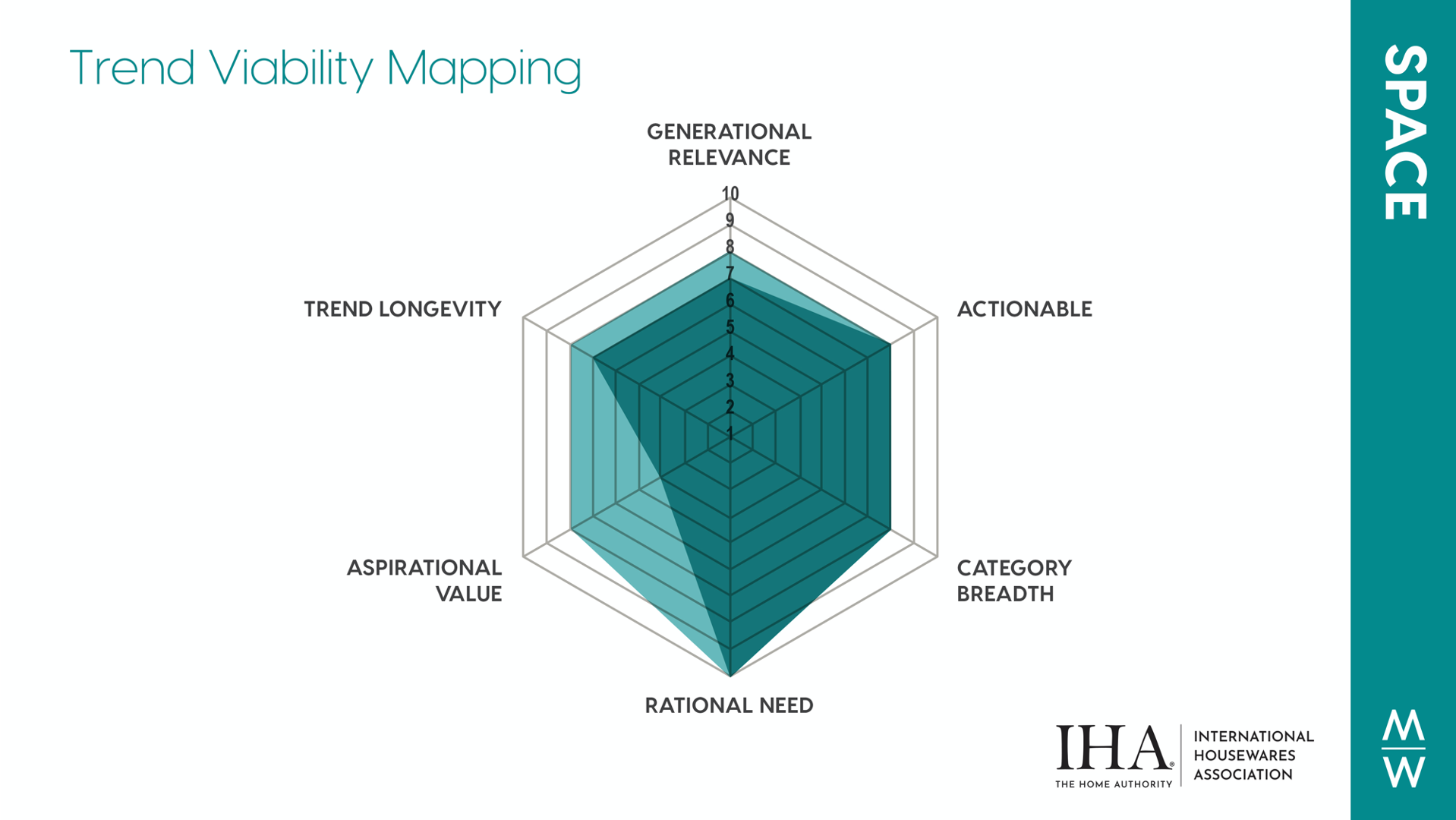Housewares product developers and retailers looking for guidance on where to focus critical resources in the coming months and years heard some valuable insights during an IHA webinar on how to help consumers make the most of their space.
This was the second in a six-part series featuring the newly created IHA Market Watch report. The first five sessions will each offer a deep-dive into one of five key consumer lifestyle trends, highlight shifts in light of COVID-19 and include implications for both suppliers and retailers. The sixth session will recap all the trends and look ahead to the rest of 2020.
Presenters were report authors: Leana Salamah, IHA vice president, marketing; Joe Derochowski, vice president and home industry advisor for The NPD Group; and Tom Mirabile, principal and founder of Springboard Futures. Peter Giannetti, editor-in-chief of HomeWorld Business, served as moderator.
Like time, “No matter where you are, you always want more space,” said Mirabile. “It doesn’t matter what size your home is.”
And the reality is that many more consumers are living in smaller spaces…or sharing their space with roommates or different generations of family members. So, what happens when you factor in COVID-19 which has forced many people to work from home, go to school from home…basically do everything from home?
“The amount of time we’re spending in our homes right now just makes everyone re-evaluate the space they’re in and what it really means to them,” said Salamah.
Our living spaces have evolved from a physical need to an emotional need. In other words, what started out as more of a place for shelter is now considered an oasis.
“It used to be that space was very much a rational thing; but now, it’s also a very personal thing…as in ‘I need some space to breathe,’” said Mirabile.
That explains why space’s aspirational value jumped from a rating of 4 in March when the IHA Market Watch report was released to an 8 today. Ratings for generational relevance and trend longevity increased slightly, while the other ratings stayed the same (including a rational need of 10). The trend viability mapping system was developed by Springboard Futures for IHA.
Both effective storage and organization address not just a functional need, but a higher need that consumers have in terms of health and wellness. “It brings feelings of calmness and control,” said Derochowski, and promotes our ability to relax at home.
Three ways product developers can help consumers meet their physical and emotional space needs:
- Combine the functions of two or more separate products
- Derochowski shared that consumers are now eating 15% more dinners at home, and that creates more pressure to diversify meals. Any product that helps them make more than one type of meal – or does more than one thing – helps relieve this pressure, without creating clutter.
- Store products in a compact manner
- This doesn’t just apply to kitchen items like nesting bowls or measuring cups. Salamah encouraged developers of products for all parts of the house to think about how design can help consumers save space.
- “This is low-hanging fruit,” said Mirabile. “Better design in terms of the space things occupy should be your first order of business.”
- Make storage beautiful
- Clear plastic bins may do the trick, but the decorative quality is important, said Salamah.
- Anything that helps consumers feel organized, but also projects their own personal style achieves two goals.
For retailers, advancements in technology and logistics can make a small store seem much larger – and help merchandise the space trend to consumers. Ways retailers can take advantage include:
- Focus on fit
- Share storage dimensions upfront, and consider displaying products in both storage and full usage mode.
- Consider augmented reality (AR) to help consumers visualize how a product will fit in their space.
- Bring online inventory in-store
- Even small retailers can now use technology to let a customer see all the color, style or function options that are available for a given product – and easily order in-store for home delivery.
- With the advent of online shopping, consumers are more willing to wait a day or two for a product to be shipped to them, moderator Giannetti pointed out.
- Demonstrate accessibility
- Showing in advance how a product can work for multiple generations can help eliminate the need to buy multiple products. Both vendors and retailers can help here, said Derochowski.
Upcoming sessions in the IHA Market Watch webinar series include:
- Thursday, July 16, 1 p.m. CDT. Macro trend – Experience. Register here.
- Tuesday, July 21, 1 p.m. CDT. Macro trend – Wellness. Register here.
- Thursday, July 23, 1 p.m. CDT. Macro trend – Responsibility. Register here.
- Tuesday, July 28, 1 p.m. CDT. Trend Wrap Up and Look Ahead. Register here.
The webinars are free, but registration is required. The webinars will be posted on the Show website, TheInspiredHomeShow.com after each is broadcast.
To watch the entire webinar on Space, go to TheInspiredHomeShow.com. To download a complimentary copy of the 2020 IHA Market Watch Report, go to https://www.theinspiredhomeshow.com/downloads/marketwatch-2020/


